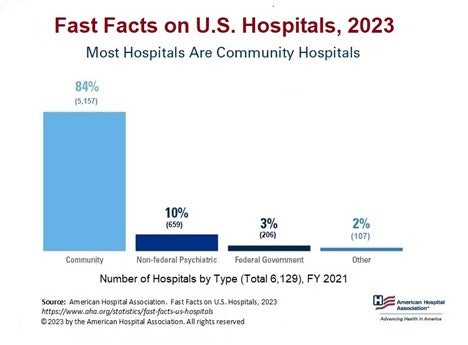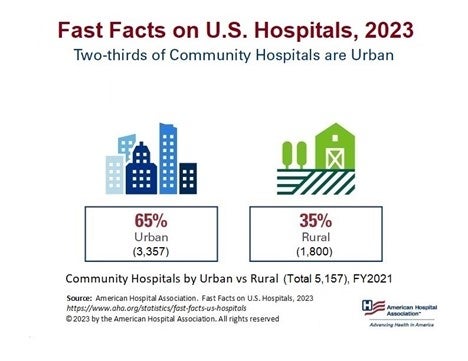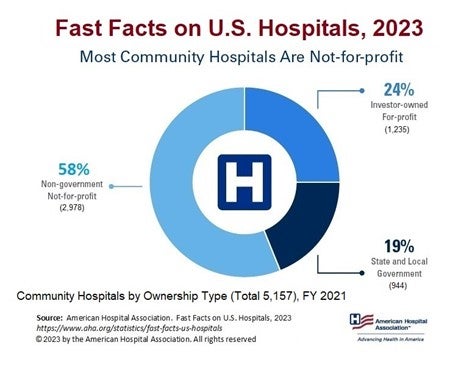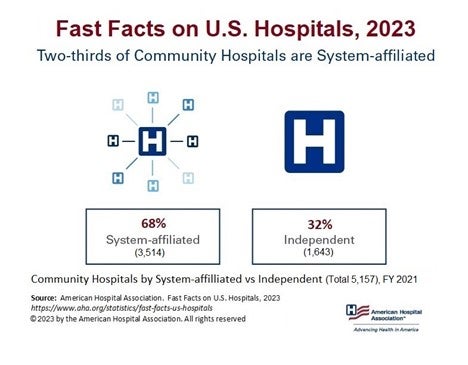80 Hospital Statistics, Facts & Demographics
In this roundup of 80 hospital statistics, facts & demographics we’re going to gain valuable insights into the healthcare landscape.
Top 10 Hospital Statistics
- Hospital errors and medical mistakes are the third leading cause of death in the U.S.
- Approximately 1 in 31 hospital patients are affected by hospital-acquired infections.
- Around 30% of hospital patients experience some form of harm during their stay, with about 2% of those incidents resulting in death.
- The average cost of a hospital stay in the U.S. is $15,734.
- Over 130 people die from opioid-related overdoses every day in the U.S.
- The U.S. has a higher rate of maternal mortality than any other developed country.
- The global digital health market is expected to reach over $500 billion by 2025.
- In 2019, the U.S. spent over $3.6 trillion on healthcare, with hospital care accounting for over 30% of that spending.
- Over 5 million people work in the healthcare industry in the U.S.
- Hospital emergency departments treat over 140 million patients every year.

How Many People Work in the Healthcare Industry in the U.S.?
- Employment in the healthcare and social assistance sector is projected to grow by 15% from 2019 to 2029, according to the Bureau of Labor Statistics (BLS).
- This growth is expected to add approximately 2.4 million new jobs to the sector over the next decade.
- The healthcare industry is likely to see continued demand for services and workers as the U.S. population grows and ages.
- Ongoing developments in medical technology and treatment options may create new opportunities for highly skilled healthcare professionals.
- The healthcare industry is expected to be a major driver of job growth and economic activity in the U.S. over the next decade.
Number of People Working in Healthcare in the U.K
- As of 2020, there were approximately 1.6 million people working in the healthcare industry in the U.K
- This represents around 5% of the total workforce in the U.K
- The largest group of healthcare workers is nurses and midwives, who make up around 28% of the total healthcare workforce.
- Other major groups include healthcare support workers (25%), medical practitioners (23%), and allied health professionals (16%).
Prevalence of Medical Conditions and Diseases Among Hospital Patients
- Approximately 1 in 31 hospital patients has at least one infection related to their healthcare (CDC).
- Heart failure is the leading cause of hospitalization for adults over age 65 in the U.S. (American Hospital Association).
- An estimated 1 in 5 adults in the U.S. experiences mental illness each year, and many of these individuals may seek treatment in hospitals or other healthcare settings (National Institute of Mental Health).
- Cancer is a leading cause of hospitalization and death in the U.S., with an estimated 1.8 million new cancer cases and 606,520 cancer deaths in 2020 (American Cancer Society).
- Unintentional injuries are a leading cause of death and disability in the U.S., with an estimated 39 million emergency department visits related to injuries each year (CDC).

Most Common Conditions Among Patients in the Emergency Room
Based on data from various sources, including the National Hospital Ambulatory Medical Care Survey, the following conditions are among the most commonly treated in emergency rooms:
- Chest pain or heart-related symptoms: 7.6 million visits per year (CDC)
- Injuries and trauma (such as bone fractures or head injuries): 29.4 million visits per year (CDC)
- Respiratory distress or difficulty breathing: 4.4 million visits per year (CDC)
- Abdominal pain or gastrointestinal issues: 4.0 million visits per year (CDC)
- Infections (such as pneumonia or urinary tract infections): 2.3 million visits per year (CDC)
- Seizures or other neurological symptoms: 1.2 million visits per year (CDC)
- Allergic reactions or anaphylaxis: 1.0 million visits per year (CDC)
- Mental health crises (such as suicidal ideation or acute psychosis): 2.2 million visits per year (SAMHSA)
- Substance abuse or overdose: 1.3 million visits per year (SAMHSA)
Most Common Conditions Among Patients in the Emergency Room In U.K
- Chest pain and related symptoms
- Respiratory infections and related symptoms
- Abdominal pain and related symptoms
- Fractures and other injuries
- Mental health conditions, such as anxiety and depression
Number of all Hospital Beds in the U.S. From 2000 to 2018
Number of hospital beds in the U.S. from 2000 to 2020, based on data from the American Hospital Association:
- 2000: 969,000
- 2005: 933,000
- 2010: 910,000
- 2015: 897,961
- 2018: 924,107

Number of all Hospital Beds in the U.K From 2000 to 2018
- In 2000, there were approximately 239,000 hospital beds available in England.
- By 2018, the number had decreased to around 141,000 beds.
While there has been a decrease in the total number of hospital beds in recent years, this trend may not necessarily reflect a reduction in healthcare capacity.
Number of all Hospital Beds in the Asia From 2000 to 2018
- According to the World Health Organization (WHO), the total number of hospital beds in Asian countries increased by 1.5 million between 2000 and 2015.
- In 2000, there were approximately 7.3 million hospital beds in Asia, compared to 8.8 million in 2015.
- For example, Japan has one of the highest densities of hospital beds in the world, with around 13 beds per 1,000 people as of 2017.
- By contrast, many countries in Southeast Asia have much lower densities of hospital beds, with some countries having fewer than one bed per 1,000 people.
Total Number of Hospital Admissions in the U.S. from 2000 to 2018
- 2000: 34,122,000
- 2005: 37,178,000
- 2010: 35,102,000
- 2015: 35,987,000
- 2018: 36,616,000
Total Number of Hospital Admissions in the U.K from 2000 to 2018
- In 2000-2001, there were approximately 12.7 million hospital admissions in England.
- By 2017-2018, the number had increased to around 16.8 million admissions.
It's worth noting that hospital admissions can vary greatly from year to year depending on various factors such as changes in healthcare policies, population demographics, and advancements in medical technology.
Hospital Bed Occupancy Rate in the U.S. from 1960 to 2019
According to data from the American Hospital Association (AHA), here is a breakdown of the average hospital bed occupancy rate in the U.S. from 1960 to 2019:
- 1960: 63.5%
- 1970: 72.6%
- 1980: 70.1%
- 1990: 63.7%
- 2000: 63.7%
- 2010: 65.4%
- 2015: 66.5%
- 2018: 66.6%
- 2019: This is the most recent year for which data is available and the average occupancy rate was 66.6%.

Hospital bed Occupancy Rate in the U.K From 1960 to 2019
- In 1960, the occupancy rate was approximately 80%.
- By 1980, it had decreased to around 70%.
- However, in recent years, the occupancy rate has been steadily increasing.
- In 2019, the average bed occupancy rate was approximately 92% in England.
It's worth noting that hospital bed occupancy rates can vary greatly depending on various factors such as changes in healthcare policies, population demographics, and disease outbreaks.
Average Length of Stay
- In 2019, the average length of stay for a hospital admission was 4.8 days.
- This has decreased from an average length of stay of 7.3 days in 1980.
The Average Length of Stay in a U.K Hospital
- The average length of stay in a U.K hospital was around 6 days, according to NHS Digital data from 2019-20.
Hospital Readmission Rates
- In 2019, the Medicare Hospital Readmissions Reduction Program penalized more than 2,500 hospitals for excessive readmissions.
Nurse-to-Patient Ratio
- The American Nurses Association recommends a maximum of four patients per nurse in medical-surgical units and a maximum of two patients per nurse in intensive care units.
FAQs
What is the difference between a hospital and a clinic?
A hospital is a healthcare facility that provides medical treatment and care to patients who require more intensive or specialized services than those provided in a clinic. Clinics, on the other hand, typically offer primary and preventive care services, such as check-ups and vaccinations.
How are hospitals funded?
Hospitals are funded through a combination of sources, including government programs (such as Medicare and Medicaid), private insurance payments, and out-of-pocket payments from patients. Some hospitals may also receive funding from charitable donations or grants.
Can I choose which hospital I go to for treatment?
In many cases, patients have some choice over which hospital they receive treatment at. However, this may depend on factors such as the type of insurance coverage they have or the availability of certain types of treatments at different facilities.
What should I bring with me when I go to the hospital?
When you go to the hospital for treatment or surgery, it's important to bring any relevant medical records or information (such as previous test results or medication lists). You should also bring comfortable clothing and any personal items you may need during your stay (such as toiletries or reading materials).
How long will I stay in the hospital?
The length of your hospital stay will depend on several factors, including the type of treatment you require and how quickly you recover. Some procedures may only require an overnight stay, while others may require several weeks of recovery time in the hospital.
What if I can't afford to pay my hospital bills?
If you are unable to pay your hospital bills, there may be options available to help you cover these costs. Many hospitals offer financial assistance programs that can help patients pay for their care based on their income level or other factors. Additionally, you may be able to negotiate payment plans with your healthcare provider or seek assistance from charitable organizations that provide financial support to patients in need.
References
https://www.statista.com/topics/1074/hospitals/
https://www.aha.org/statistics/fast-facts-us-hospitals
https://www.slideshare.net/zulfiquer732/hospital-statistics-79835548
https://www.ncbi.nlm.nih.gov/books/NBK91979/
https://www.ahadata.com/aha-hospital-statistics
https://www.brightfuturesny.com/post/healthcare-industry-statistics


